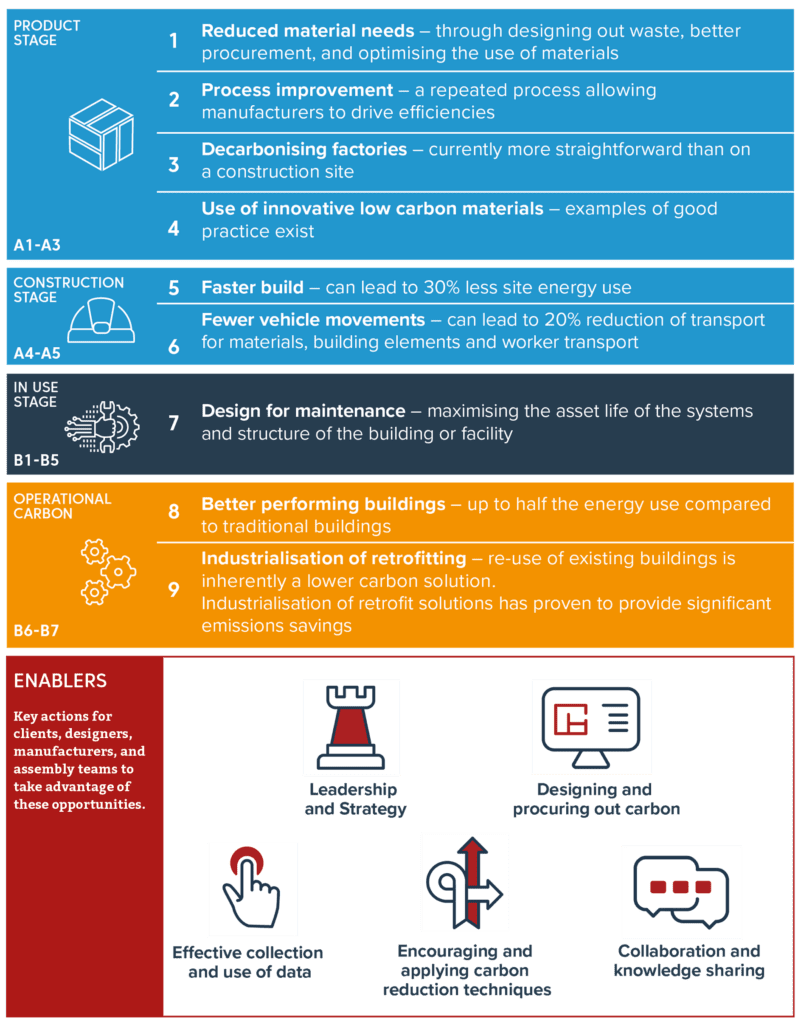The built environment is central to achieving the decarbonisation of our society, and in response some have looked to offsite construction as a way of rolling out low carbon or even ‘Net Zero’ buildings on an industrial scale.
There are compelling arguments for the carbon and resource efficiency benefits of taking production from construction sites into a controlled environment, as well as cutting embodied carbon through optimisation of designs. There are also examples of projects in which whole life carbon has been cut considerably using offsite methods, and offsite manufacturers leading the way in consistently producing excellent low carbon assets.
Confidence in the opportunities are high, but there is a fair way to go for good practice to be normalised across the sector.
In the latest report by the Supply Chain Sustainability School, ‘Whole Life Carbon Guidance for Offsite Construction’, we recommend specific actions across the project life cycle to help optimise the use of offsite to reduce embodied and operational carbon.
The opportunities for carbon reductions are greatest at the project brief and early design stages. Embodied carbon and operational energy use targets should be included as design objectives within the brief, and procurement processes should integrate the social cost of carbon to make the value case for these targets.
Clients can also create the conditions for continual improvement, by encouraging standardisation of building types, and creating a pipeline of work through collaborative procurement (e.g. the Building Better Framework or the Edinburgh Home Demonstrator.
Designers equipped with a good understanding of the potential of offsite and modern methods of construction are well placed to advocate for their use in the service of low carbon goals.
Understanding and balancing operational and embodied carbon impacts of design choices is a key skill which can be aided by early whole life carbon assessments and digital design tools such as H\Bert. Innovations in design can come from early communication with offsite manufacturers, for example Buro Happold’s use of the Cree modular timber-concrete-hybrid structure in the EDGE Suedkreuz building.

The 9 key opportunities for offsite to reduce whole life carbon, and the 5 enablers to optimise these opportunities, put forward by the new Supply Chain Sustainability School report.
In offsite construction projects, material and energy use shifts away from the construction site and contractors to the manufacturers of the elements and structures of the asset. The concentration of activity under one roof presents an opportunity for improved carbon data management, as well as material efficiency and process optimisation. Manufacturers should take the lead on transparency, working towards greater EPD coverage for products, and exploring the development of materials passports.
Assets which utilise offsite manufacture have been found to take around 50-60% of the time to build, with associated reductions from energy and fuel of around 80%. However, data capture and collation for projects is still considered a challenge, especially for logistics information. For this to improve, clear expectations should be set by contractors, and guidance on requirements shared with sufficient lead in time. Tagging and tracking of prefabricated components and assemblies will help with this.
Our research has shown that there is excellent work taking place in the world of offsite construction, with some manufacturers leading the way in consistently producing innovative low carbon buildings. But ultimately, premanufacture is only one tool in the toolbox, along with others such as material choices, integration of renewable technologies, and passive design.
Effective utilisation of these tools requires low carbon to be a focus of a project from the outset. Just because an asset or element is constructed offsite, does not mean it is immune from being a waste of materials and carbon!
Do you need help understanding the carbon impact of your offsite projects? Get in touch with us today.

Naomi Pratt
Consultant
naomi@actionsustainability.com

This was posted in All Topics, Energy & Carbon, ISO 20400 Sustainable Procurement
Our Head of Climate, Dr James Cadman, shares his insights on how organisations can effectively embed carbon reduction into their sustainable procurement practices using the ISO 20400 framework.
Read Article
This was posted in Energy & Carbon, ISO 20400 Sustainable Procurement
Developed by Action Sustainability, "Responsible Sourcing of HVO – A Comprehensive Guide" explores how to responsibly procure Hydrotreated Vegetable Oil (HVO).
Read Article
This was posted in Energy & Carbon, Sustainability Strategy
Action Sustainability is partnering with SKAO for the launch of the CO2 Performance Ladder pilot in the United Kingdom.
Read Article